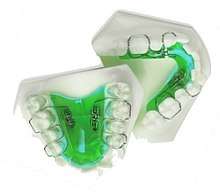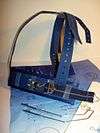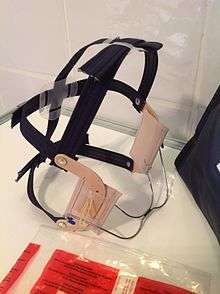Orthodontic technology
Orthodontic technology is a specialty of dental technology that is concerned with the design and fabrication of dental appliances for the treatment of malocclusions, which may be a result of tooth irregularity, disproportionate jaw relationships, or both.
the orthodontic appliance are divided into three group:1)Removable Appliance 2)Removable Fixed Appliance 3)Fixed Appliance[1]
There are three main types of orthodontic appliances: active, passive and functional. All these types can be fixed or removable.
Active appliances
An active appliance is a device used to apply forces to the teeth to change the relationship of the teeth.
Removable active appliances
Removable active appliances are intended for simple tipping movements. Use of removable appliances in modern orthodontics is much more limited than in the past due to their various shortcomings.
- Expansion and labial segment alignment appliance (ELSAA)[2]
Fixed active appliances
Edward Angle, regarded as the father of American orthodontics,[3] developed many universal fixed active appliances, unifying orthodontic practice.[4] See detailed description at Edward Angle.
- Begg lightwire appliances
- Pre-adjusted edgewise appliances
- Self-ligating edgewise appliances
- Bi helix
- Tri helix
- Quad helix
- Palatal expander/rapid maxillary expansion appliance (RME)
- Tip-edge appliance
Functional appliances

There is a totally different orthodontics approach without extraction and pain, is called functional orthodontics, the functional orthodontic technology is different and called functional appliance, that is an appliance that produces all or part of its effect by altering the position of the mandible/maxilla. Also known as dentofacial orthopaedic appliances, these appliances utilize the muscle action of the patient and responses of nervous system to produce orthodontic or orthopaedic forces. Various functional appliances have been described. There is a List of Orthodontic Functional Appliances.
Orthodontic headgear

Orthodontic headgear is a type of appliance attached to dental braces that aids in correcting more severe bite problems.
Headgear is an orthodontic appliance for the correction of Class II correction, typically used in growing patients to correct overbites by holding back the growth of the upper jaw, allowing the lower jaw to catch up.
The headgear can also be used to make more space for teeth to come in. The headgear is then attached to the molars (via molar headgear bands & tubes), and helps to push or draw them backwards in the mouth, opening up space for the front teeth to be moved back using braces and bands.

Headgear needs to be worn approximately 12 to 22 hours a day to be truly effective in correcting the overbite, and treatment is usually anywhere from 6 to 18 months in duration, depending on the severity of the overbite and how much a patient is growing.[5]
Orthodontic facemask and reverse-pull headgear

Facemask or reverse-pull headgear is used to control the growth of the maxillary and mandibular bones during orthodontic treatment.
The appliance is used in growing patients to correct under bites (known as a Class III orthodontic problem) by pulling forward and assisting the growth of the upper jaw, allowing the upper jaw to catch up.
Facemasks or reverse-pull headgear needs to be worn approximately 12 to 22 hrs to be truly effective in correcting the under bite, usually anywhere from 6 to 18 months depending on the severity of the bite and how much a patient is growing.[5]
The appliance normally consists of a frame or a centre bars that are strapped to the patients head during a fitting appointment. The frame has a section which is positioned in front of the patients mouth, which allows for the attachment of elastic or rubber bands directly into the mouth area. These elastics are then hooked onto the child's braces (brackets and bands) or appliance fitted in his or her mouth.
This creates a forward 'pulling' force to pull the upper jaw forward.
Fixed functional appliances
- Herbst appliance: A Herbst appliance corrects overbites by holding the lower jaw in a protrusive position. It is similar to the twin block appliance except that it is fixed in place and hence non-removable. This appliance is most commonly used in non-compliant patients. The Herbst appliance is very effective in correcting large overbites due to small lower jaws in patients that are growing.
- Twin block appliance: The twin block appliance is a removable appliance, and its high comfort level allows you to wear it 24 hours a day. This appliance actually is made up of two separate appliances that work together as one. The upper plate includes an optional expansion screw to widen your upper arch, if needed, as well as pads to cover your molars. The lower plate includes pads to cover your lower bicuspids. These two appliances interlock at an angle, and they move your lower jaw forward and lock it into the ideal position when you bite together. This new position, while temporary, will eventually become the permanent corrected position.
See also
References
- ↑
- ↑ Littlewood, S J (22 September 2001). "Orthodontics: The role of removable appliances in contemporary orthodontics". British Dental Journal. BDJ 191: 304–310. doi:10.1038/sj.bdj.4801170.
- ↑ Peck, Sheldon (Nov 2009). "A biographical portrait of Edward Hartley Angle, the first specialist in orthodontics, part 1". Angle Orthod. United States. 79 (6): 1021–7. doi:10.2319/021009-93.1. ISSN 0003-3219. PMID 19852589.
- ↑ King, Sam (18 January 2015). "The History of Orthodontic Technology". King Orthodontics. Retrieved 4 April 2015.
- 1 2 Children and Orthodontics: Types of Braces, Retainers, Headgear and Facemasks www.webmd.com/oral-health/guide/children-and-orthodontics WebMD describes common types of orthodontics for children, including braces headgear, and retainers.